Physical Flood Vulnerability Assessment in a GIS Environment Using Morphometric Parameters: A Case Study from Volos, Greece
Abstract
1. Introduction
2. Study Area
3. Datasets and Methodology
3.1. Flood-Vulnerability Criteria
3.1.1. Slope
3.1.2. Flow Accumulation
3.1.3. Land Use/Land Cover
3.1.4. Geology
3.1.5. Flood History
3.1.6. Burned Areas
3.2. Verification of Flood-Vulnerability’s Map Accuracy
3.3. Classification and Rating of the Criteria
3.4. Analytical Hierarchy Process (AHP)
3.4.1. Calculation of Criteria Weight
3.4.2. Calculation of Flood Susceptibility Index (FSI)
3.4.3. Validation of Results
4. Results
4.1. Calculation of Each Flood Vulnerability Factor
4.1.1. Slope
4.1.2. Flow Accumulation
4.1.3. Land Use/Cover
4.1.4. Geology
4.1.5. Flood History
4.1.6. Burned Areas
4.2. Calculation of Weighting Coefficients and Consistency Ratio Index
4.3. Flood Susceptibility Index (FSI)
4.4. Results Verification
4.4.1. Sensitivity Analysis
4.4.2. Flood-Vulnerability Map Verification
4.5. Discussion
5. Conclusions
Author Contributions
Funding
Data Availability Statement
Conflicts of Interest
References
- Tellman, B.; Sullivan, J.A.; Kuhn, C.; Kettner, A.J.; Doyle, C.S.; Brakenridge, G.R.; Erickson, T.A.; Slayback, D.A. Satellite imaging reveals increased proportion of population exposed to floods. Nature 2021, 5967870, 80–86. [Google Scholar] [CrossRef]
- Cao, W.; Zhou, Y.; Güneralp, B.; Li, X.; Zhao, K.; Zhang, H. Increasing global urban exposure to flooding: An analysis of long-term annual dynamics. Sci. Total Environ. 2022, 817, 153012. [Google Scholar] [CrossRef]
- Adeel, Z.; Alarcón, A.M.; Bakkensen, L.; Franco, E.; Garfin, G.M.; McPherson, R.A.; Méndez, K.; Roudaut, M.B.; Saffari, H.; Wen, X. Developing a comprehensive methodology for evaluating economic impacts of floods in Canada, Mexico and the United States. Int. J. Disaster Risk Reduct. 2020, 50, 101861. [Google Scholar] [CrossRef]
- Rentschler, J.; Salhab, M.; Jafino, B.A. Flood exposure and poverty in 188 countries. Nat. Commun. 2022, 13, 3527. [Google Scholar] [CrossRef]
- Piacentini, T.; Carabella, C.; Boccabella, F.; Ferrante, S.; Gregori, C.; Mancinelli, V.; Pacione, A.; Pagliani, T.; Miccadei, E. Geomorphology-based analysis of flood critical areas in small hilly catchments for civil protection purposes and early warning systems: The case of the Feltrino Stream and the Lanciano urban area (Abruzzo, central Italy). Water 2020, 12, 2228. [Google Scholar] [CrossRef]
- Rentschler, J.; Avner, P.; Marconcini, M.; Su, R.; Strano, E.; Vousdoukas, M.; Hallegatte, S. Global evidence of rapid urban growth in flood zones since 1985. Nature 2023, 6227981, 87–92. [Google Scholar] [CrossRef]
- Brunner, M.I.; Slater, L.; Tallaksen, L.M.; Clark, M. Challenges in modeling and predicting floods and droughts: A review. Wiley Interdiscip. Rev. Water 2021, 8, e1520. [Google Scholar] [CrossRef]
- Mazzoleni, M.; Dottori, F.; Cloke, H.L.; Di Baldassarre, G. Deciphering human influence on annual maximum flood extent at the global level. Commun. Earth Environ. 2022, 3, 262. [Google Scholar] [CrossRef]
- Hoang, D.; Liou, Y. Assessing the influence of human activities on flash flood susceptibility in mountainous regions of Vietnam. Ecol. Indic. 2023, 158, 111417. [Google Scholar] [CrossRef]
- Stavropoulos, S.; Zaimes, G.N.; Filippidis, E.; Diaconu, D.C.; Emmanouloudis, D. Mitigating flash floods with the use of new technologies: A multi-criteria decision analysis to map flood susceptibility for Zakynthos Island, Greece. J. Urban Reg. Anal. 2020, 12, 233–248. [Google Scholar] [CrossRef]
- Goodarzi, M.R.; Poorattar, M.J.; Vazirian, M.; Talebi, A. Evaluation of a weather forecasting model and HEC-HMS for flood forecasting: Case study of Talesh catchment. Appl. Water Sci. 2024, 14, 34. [Google Scholar] [CrossRef]
- Karkani, A.; Evelpidou, N.; Tzouxanioti, M.; Petropoulos, A.; Santangelo, N.; Maroukian, H.; Spyrou, E.; Lakidi, L. Flash flood susceptibility evaluation in human-affected areas using geomorphological methods—The case of 9 August 2020, Euboea, Greece. A GIS-based approach. GeoHazards 2021, 2, 366–382. [Google Scholar] [CrossRef]
- Shekar, P.R.; Mathew, A. Morphometric analysis of watersheds: A comprehensive review of data sources, quality, and geospatial techniques. Watershed Ecol. Environ. 2023, 6, 13–25. [Google Scholar] [CrossRef]
- Rahman, M.; Ningsheng, C.; Mahmud, G.I.; Islam, M.; Pourghasemi, H.R.; Ahmad, H.; Habumugisha, J.M.; Washakh, R.M.A.; Alam, M.; Liu, E.; et al. Flooding and its relationship with land cover change, population growth, and road density. Geosci. Front. 2021, 12, 101224. [Google Scholar] [CrossRef]
- Evelpidou, N.; Tzouxanioti, M.; Spyrou, E.; Petropoulos, A.; Karkani, A.; Saitis, G.; Margaritis, M. GIS-based assessment of fire effects on flash flood hazard: The case of the Summer 2021 forest fires in Greece. GeoHazards 2022, 4, 1–22. [Google Scholar] [CrossRef]
- Toosi, G. Influence of vegetation in the flood drainage ditch. J. Civ. Eng. Res. 2023, 5, 16–21. [Google Scholar] [CrossRef]
- Agonafir, C.; Lakhankar, T.; Khanbilvardi, R.; Krakauer, N.; Radell, D.; Devineni, N. A review of recent advances in Urban Flood Research. Water Secur. 2023, 19, 100141. [Google Scholar] [CrossRef]
- Kumar, V.; Sharma, K.V.; Caloiero, T.; Mehta, D.J.; Singh, K. Comprehensive overview of flood modeling approaches: A review of recent advances. Hydrology 2023, 10, 141. [Google Scholar] [CrossRef]
- Antzoulatos, G.; Kouloglou, I.-O.; Bakratsas, M.; Moumtzidou, A.; Gialampoukidis, I.; Karakostas, A.; Lombardo, F.; Fiorin, R.; Norbiato, D.; Ferri, M.; et al. Flood hazard and risk mapping by applying an explainable machine learning framework using satellite imagery and GIS data. Sustainability 2022, 14, 3251. [Google Scholar] [CrossRef]
- Xafoulis, N.; Farsirotou, E.; Kotsopoulos, S.; Alamanis, N. Flood hazard assessment in a mountainous river basin in Thessaly, Greece, based on 1D/2D numerical simulation. Energy Nexus 2022, 8, 100142. [Google Scholar] [CrossRef]
- Evelpidou, N.; Cartalis, C.; Karkani, A.; Saitis, G.; Philippopoulos, K.; Spyrou, E. A GIS-based assessment of flood hazard through track records over the 1886–2022 period in Greece. Climate 2023, 11, 226. [Google Scholar] [CrossRef]
- Cinelli, M.; Kadziński, M.; Gonzalez, M.; Słowiński, R. How to support the application of multiple criteria decision analysis? Let us start with a comprehensive taxonomy. Omega 2020, 96, 102261. [Google Scholar] [CrossRef] [PubMed]
- Taherdoost, H.; Madanchian, M. Multi-criteria decision making (MCDM) methods and concepts. Encyclopedia 2023, 3, 77–87. [Google Scholar] [CrossRef]
- Akhter, S.; Rahman, M.M.; Monir, M.M. Flood susceptibility analysis to sustainable development using MCDA and support vector machine models by GIS in the selected area of the Teesta River floodplain, Bangladesh. HydroResearch 2025, 8, 127–138. [Google Scholar] [CrossRef]
- Abdullah, M.F.; Siraj, S.; Hodgett, R.E. An overview of multi-criteria decision analysis (MCDA) application in managing water-related disaster events: Analyzing 20 years of literature for flood and drought events. Water 2021, 13, 1358. [Google Scholar] [CrossRef]
- Sun, R.; Gong, Z.; Gao, G.; Shah, A. Comparative analysis of multi-criteria decision-making methods for flood disaster risk in the Yangtze River Delta. Int. J. Disaster Risk Reduct. 2020, 51, 101768. [Google Scholar] [CrossRef]
- Gul, M.; Yucesan, M.; Erdogan, M. Multi-Criteria Decision Analysis: Case Studies in Disaster Management; CRC Press: Boca Raton, FA, USA, 2022. [Google Scholar] [CrossRef]
- Feloni, E.; Mousadis, I.; Baltas, E. Flood vulnerability assessment using a GIS-based multi-criteria approach—The case of Attica region. J. Flood Risk Manag. 2019, 13 (Suppl. S1), e12563. [Google Scholar] [CrossRef]
- Vojtek, M.; Vojteková, J. Flood susceptibility mapping on a national scale in Slovakia using the Analytical hierarchy process. Water 2019, 11, 364. [Google Scholar] [CrossRef]
- Karymbalis, E.; Andreou, M.; Batzakis, D.-V.; Tsanakas, K.; Karalis, S. Integration of GIS-based multicriteria decision analysis and analytic hierarchy process for flood-hazard assessment in the Megalo Rema River Catchment (East Attica, Greece). Sustainability 2021, 13, 10232. [Google Scholar] [CrossRef]
- Allafta, H.; Opp, C.; Patra, S. Identification of groundwater potential zones using remote sensing and GIS techniques: A case study of the shatt al-arab basin. Remote Sens. 2020, 13, 112. [Google Scholar] [CrossRef]
- Rincón, D.; Khan, U.; Armenakis, C. Flood risk mapping using GIS and multi-criteria analysis: A Greater Toronto area case study. Geosciences 2018, 8, 275. [Google Scholar] [CrossRef]
- Ahmed, I.; Pan, N.D.; Debnath, J.; Bhowmik, M.; Bhattacharjee, S. Flood hazard zonation using GIS-based multi-parametric Analytical Hierarchy process. Geosyst. Geoenviron. 2024, 3, 100250. [Google Scholar] [CrossRef]
- Peker, İ.B.; Gülbaz, S.; Demir, V.; Orhan, O.; Beden, N. Integration of HEC-RAS and HEC-HMS with GIS in flood modeling and flood hazard mapping. Sustainability 2024, 16, 1226. [Google Scholar] [CrossRef]
- Saini, D.S.; Barik, D.K. Simulation of the hydraulic model HEC-RAS coupled with GIS and remote sensing to study the effect of river cross-section width in detecting flood-prone areas. J. Geol. Soc. India 2024, 100, 367–376. [Google Scholar] [CrossRef]
- Cai, T.; Li, X.; Ding, X.; Wang, J.; Zhan, J. Flood risk assessment based on hydrodynamic model and fuzzy comprehensive evaluation with GIS technique. Int. J. Disaster Risk Reduct. 2019, 35, 101077. [Google Scholar] [CrossRef]
- Kim, V.; Tantanee, S.; Suparta, W. GIS-based flood hazard mapping using HEC-RAS model: A case study of Lower Mekong River, Cambodia. Geogr. Tech. 2020, 15, 16–26. [Google Scholar] [CrossRef]
- Doorga, J.R.; Magerl, L.; Bunwaree, P.; Zhao, J.; Watkins, S.; Staub, C.G.; Rughooputh, S.D.; Cunden, T.S.; Lollchund, R.; Boojhawon, R. GIS-based multi-criteria modelling of flood risk susceptibility in Port Louis, Mauritius: Towards resilient flood management. Int. J. Disaster Risk Reduct. 2022, 67, 102683. [Google Scholar] [CrossRef]
- Giurea, A.; Comănescu, L.; Dobre, R.; Nedelea, A.; Mirea, I. Flood risk assessment using multi-criteria spatial analysis case study: Gilort River between Bălcești and Bolbocești. Water 2024, 16, 1760. [Google Scholar] [CrossRef]
- Membele, G.M.; Naidu, M.; Mutanga, O. Examining flood vulnerability mapping approaches in developing countries: A Scoping review. Int. J. Disaster Risk Reduct. 2021, 69, 102766. [Google Scholar] [CrossRef]
- Efraimidou, E.; Spiliotis, M. A GIS-based flood risk assessment using the Decision-Making Trial and Evaluation Laboratory approach at a regional scale. Environ. Process. 2024, 11, 9. [Google Scholar] [CrossRef]
- Papaioannou, G.; Loukas, A.; Vasiliades, L.; Aronica, G.T. Sensitivity analysis of a probabilistic flood inundation mapping framework for ungauged catchments. Eur. Water 2017, 60, 9–16. [Google Scholar]
- Belvederesi, C.; Zaghloul, M.S.; Achari, G.; Gupta, A.; Hassan, Q.K. Modelling river flow in cold and ungauged regions: A review of the purposes, methods, and challenges. Environ. Rev. 2022, 30, 159–173. [Google Scholar] [CrossRef]
- Sahraei, R.; Kanani-Sadat, Y.; Homayouni, S.; Safari, A.; Oubennaceur, K.; Chokmani, K. A novel hybrid GIS-based multi-criteria decision-making approach for flood susceptibility analysis in large ungauged watersheds. J. Flood Risk Manag. 2022, 16, e12879. [Google Scholar] [CrossRef]
- Cutter, S.L.; Boruff, B.J.; Shirley, W.L. Social vulnerability to environmental hazards. Soc. Sci. Q. 2003, 84, 242–261. [Google Scholar] [CrossRef]
- Turner, B.L.; Kasperson, R.E.; Matson, P.A.; McCarthy, J.J.; Corell, R.W.; Christensen, L.; Eckley, N.; Kasperson, J.X.; Luers, A.; Martello, M.L.; et al. A framework for vulnerability analysis in sustainability science. Proc. Natl. Acad. Sci. USA 2003, 100, 8074–8079. [Google Scholar] [CrossRef]
- Papathoma-Köhle, M.; Neuhold, C.; Glade, T. A GIS-based vulnerability assessment for fluvial floods in Austria. Nat. Hazards Earth Syst. Sci. 2011, 11, 443–455. [Google Scholar]
- Chen, W.; Blong, R.; Jacobson, C. Assessing physical vulnerability to flood in urban areas of developing countries. Environ. Hazards 2020, 19, 417–435. [Google Scholar]
- Papaioannou, G.; Efstratiadis, A.; Vasiliades, L.; Loukas, A.; Papalexiou, S.M.; Koukouvinos, A.; Tsoukalas, I.; Kossieris, P. An operational method for Flood Directive implementation in ungauged urban areas. Hydrology 2018, 5, 24. [Google Scholar] [CrossRef]
- Papaioannou, G.; Varlas, G.; Terti, G.; Papadopoulos, A.; Loukas, A.; Panagopoulos, Y.; Dimitriou, E. Flood inundation mapping at ungauged basins using coupled hydrometeorological-hydraulic modelling: The catastrophic case of the 2006 flash flood in Volos City, Greece. Water 2019, 11, 2328. [Google Scholar] [CrossRef]
- Special Secretariat for Water, Ministry of Environment and Energy. Preliminary Assessment of the Flood Directive; Ministry of Environment and Energy: Athens, Greece, 2018. Available online: https://floods.ypeka.gr/ (accessed on 20 March 2024).
- Papaioannou, G. Flood Hazard and Risk Modelling Framework for Ungauged Streams and Watersheds. Ph.D. Thesis, University of Thessaly, Volos, Greece, 2017. [Google Scholar]
- Diakakis, M.; Mavroulis, S.; Deligiannakis, G. Floods in Greece, a statistical and spatial approach. Nat. Hazards 2012, 62, 485–500. [Google Scholar] [CrossRef]
- Lekkas, E.; Diakakis, M.; Mavroulis, S.; Filis, C.; Bantekas, Y.; Gogou, M.; Katsetsiadou, K.-N.; Mavrouli, M.; Giannopoulos, V.; Sarantopoulou, A.; et al. The early September 2023 Daniel storm in Thessaly Region (Central Greece). In Newsletter of Environmental, Disaster and Crises Management Strategies; The National and Kapodistrian University of Athens: Athens, Greece, 2023; p. 30. ISSN 2653-9454. [Google Scholar]
- Skilodimou, H.D.; Bathrellos, G.D.; Alexakis, D.E. Flood hazard Assessment mapping in burned and urban areas. Sustainability 2021, 13, 4455. [Google Scholar] [CrossRef]
- Khoeun, C.; Sok, T.; Chan, R.; Khe, S.; Ich, I.; Chan, K.; Oeurng, C. Assessing flood hazard index using Analytical Hierarchy Process (AHP) and Geographical Information System (GIS) in Stung Sen River Basin. IOP Conf. Ser. Earth Environ. Sci. 2022, 1091, 012031. [Google Scholar] [CrossRef]
- Chen, Y.; Wang, D.; Zhang, L.; Guo, H.; Ma, J.; Gao, W. Flood risk assessment of Wuhan, China, using a multi-criteria analysis model with the improved AHP-Entropy method. Environ. Sci. Pollut. Res. 2023, 30, 96001–96018. [Google Scholar] [CrossRef]
- Dash, P.; Sar, J. Identification and validation of potential flood hazard area using GIS-based multi-criteria analysis and satellite data-derived water index. J. Flood Risk Manag. 2020, 13, e12620. [Google Scholar] [CrossRef]
- Du, S.; Zhang, Z. Impact of cover change of land use on flood vulnerability in Jiangsu province. E3S Web Conf. 2021, 308, 01004. [Google Scholar] [CrossRef]
- Mitra, R.; Saha, P.; Das, J. Assessment of the performance of GIS-based analytical hierarchical process (AHP) approach for flood modelling in Uttar Dinajpur district of West Bengal, India. Geomat. Nat. Hazards Risk 2022, 13, 2183–2226. [Google Scholar] [CrossRef]
- Katsikatsos, G.; Mylonakis, J.; Vidakis, M.; Hecht, J.; Papadeas, G. Geological Map of Greece Scale 1:50,000, Sheet “Volos”; Institute of Geology and Mineral Exploration: Acharnae, Greece, 1986. [Google Scholar]
- Diakakis, M. Flood history analysis and its contribution to flood hazard assessment—The case of Marathonas, Greece. Bull. Geol. Soc. Greece 2017, 43, 1323. [Google Scholar] [CrossRef]
- Saaty, T.L. A scaling method for priorities in hierarchical structures. J. Math. Psychol. 1977, 15, 234–281. [Google Scholar] [CrossRef]
- Saaty, T.L. How to make a decision: The analytic hierarchy process. Eur. J. Oper. Res. 1990, 48, 9–26. [Google Scholar] [CrossRef]
- Saaty, T.L. The analytic hierarchy process in conflict management. Int. J. Confl. Manag. 1990, 1, 47–68. [Google Scholar] [CrossRef]
- Saaty, T.L. Decision Making with the Analytic Network Process; eBooks: Nedlands, Australia, 2006; pp. 1–26. [Google Scholar] [CrossRef]
- Saaty, R. The analytic hierarchy process—What it is and how it is used. Math. Model. 1987, 9, 161–176. [Google Scholar] [CrossRef]
- Toosi, A.S.; Calbimonte, G.H.; Nouri, H.; Alaghmand, S. River basin-scale flood hazard assessment using a modified multi-criteria decision analysis approach: A case study. J. Hydrol. 2019, 574, 660–671. [Google Scholar] [CrossRef]
- Więckowski, J.; Sałabun, W. Sensitivity analysis approaches in multi-criteria decision analysis: A systematic review. Appl. Soft Comput. 2023, 148, 110915. [Google Scholar] [CrossRef]
- Chalkias, C. Geographical Analysis Using Geoinformatics; Kallipos, Open Academic Editions: Athens, Greece, 2015; ISBN 978-960-603-453-4. [Google Scholar]
- Lappas, I.; Kallioras, A. Flood susceptibility assessment through GIS-based multi-criteria approach and analytical hierarchy process (AHP) in a river basin in Central Greece. Int. Res. J. Eng. Technol. 2019, 06, 738–751. [Google Scholar]
- Prall, M.C.; Brandt, U.S.; Halvorsen, N.S.; Hansen, M.U.; Dahlberg, N.; Andersen, K.J. A comprehensive approach for assessing social flood vulnerability and social flood risk: The case of Denmark. Int. J. Disaster Risk Reduct. 2024, 111, 104686. [Google Scholar] [CrossRef]
- Shastry, A.; Carter, E.; Coltin, B.; Sleeter, R.; McMichael, S.; Eggleston, J. Mapping floods from remote sensing data and quantifying the effects of surface obstruction by clouds and vegetation. Remote Sens. Environ. 2023, 291, 113556. [Google Scholar] [CrossRef]

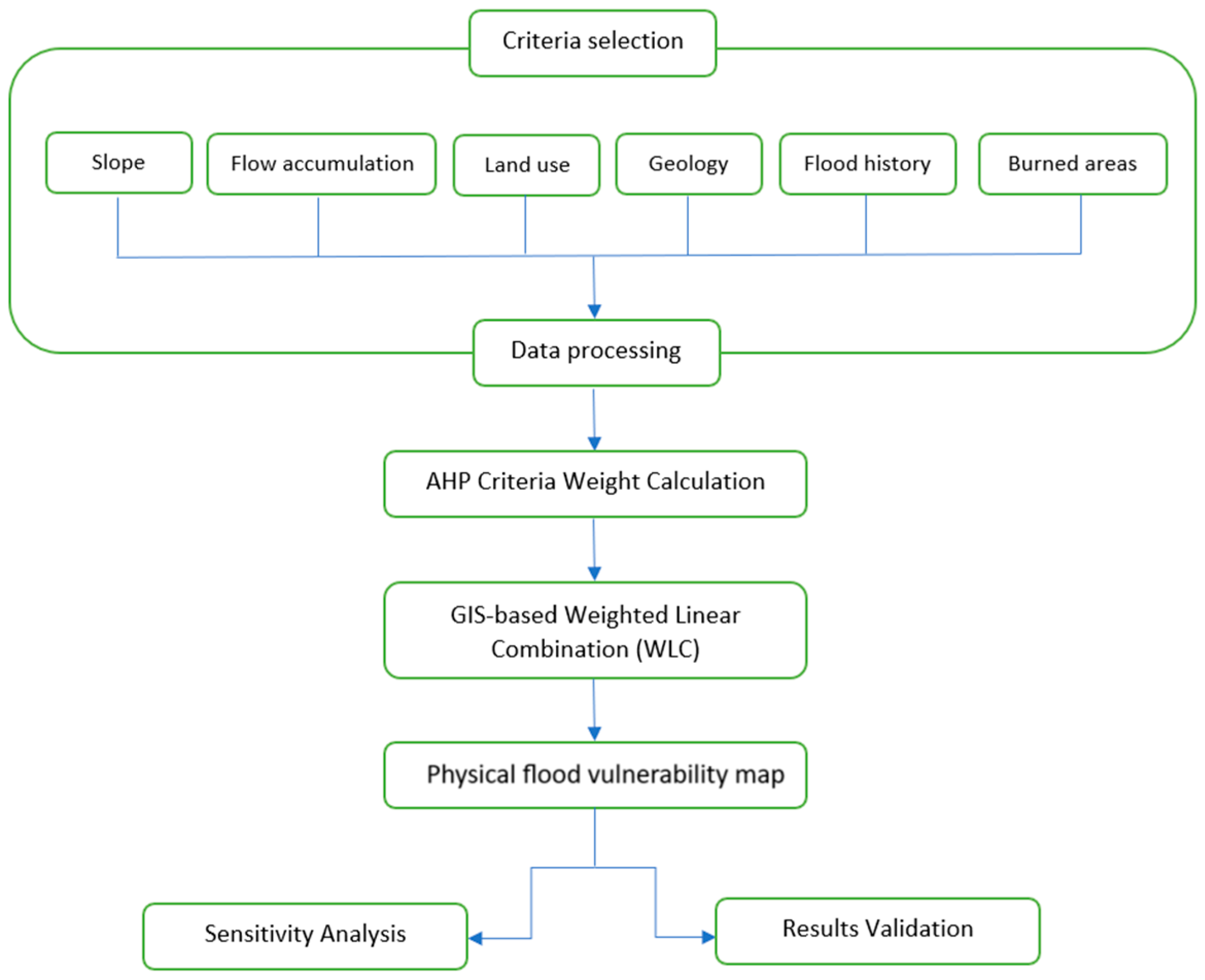

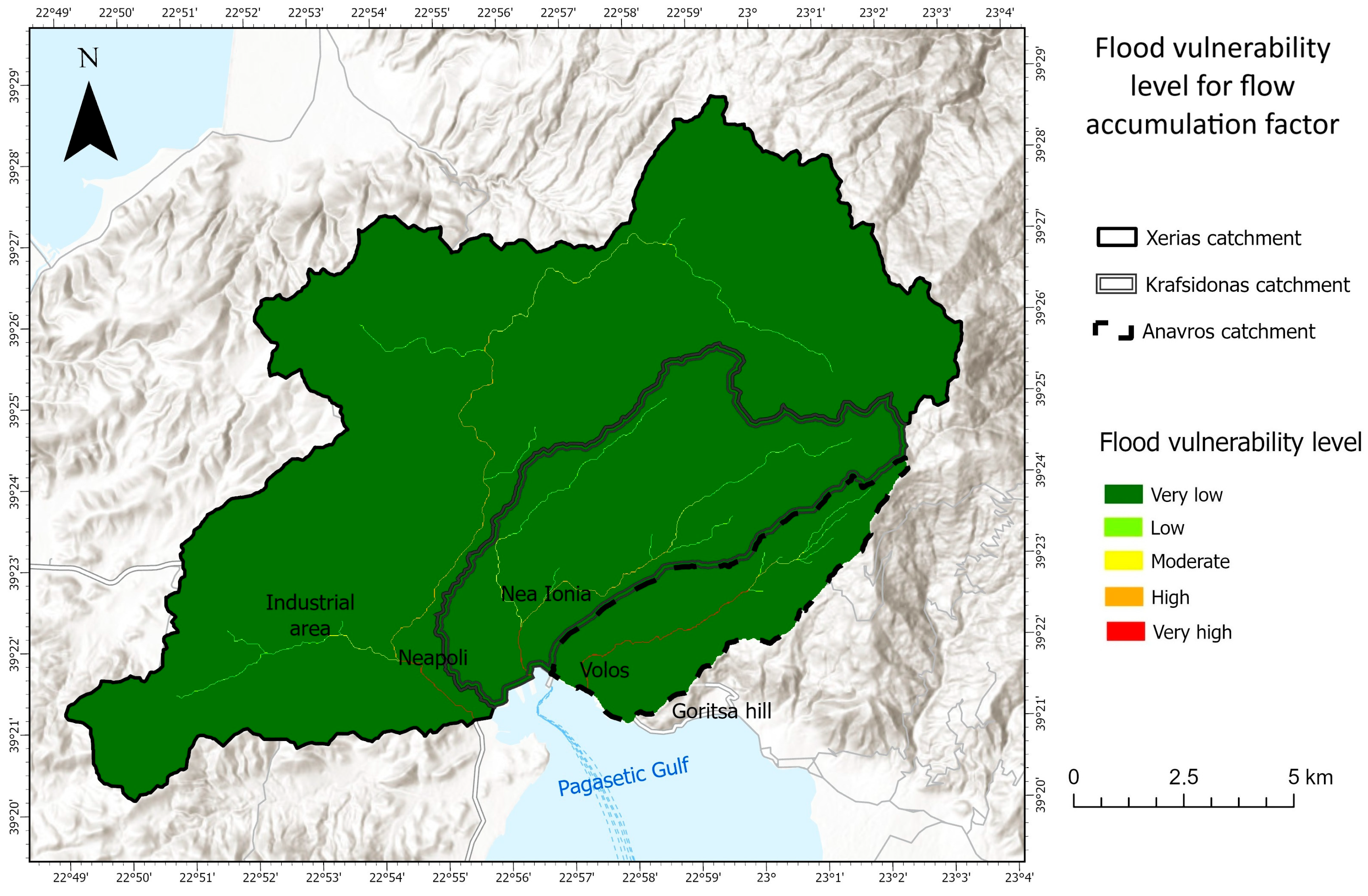

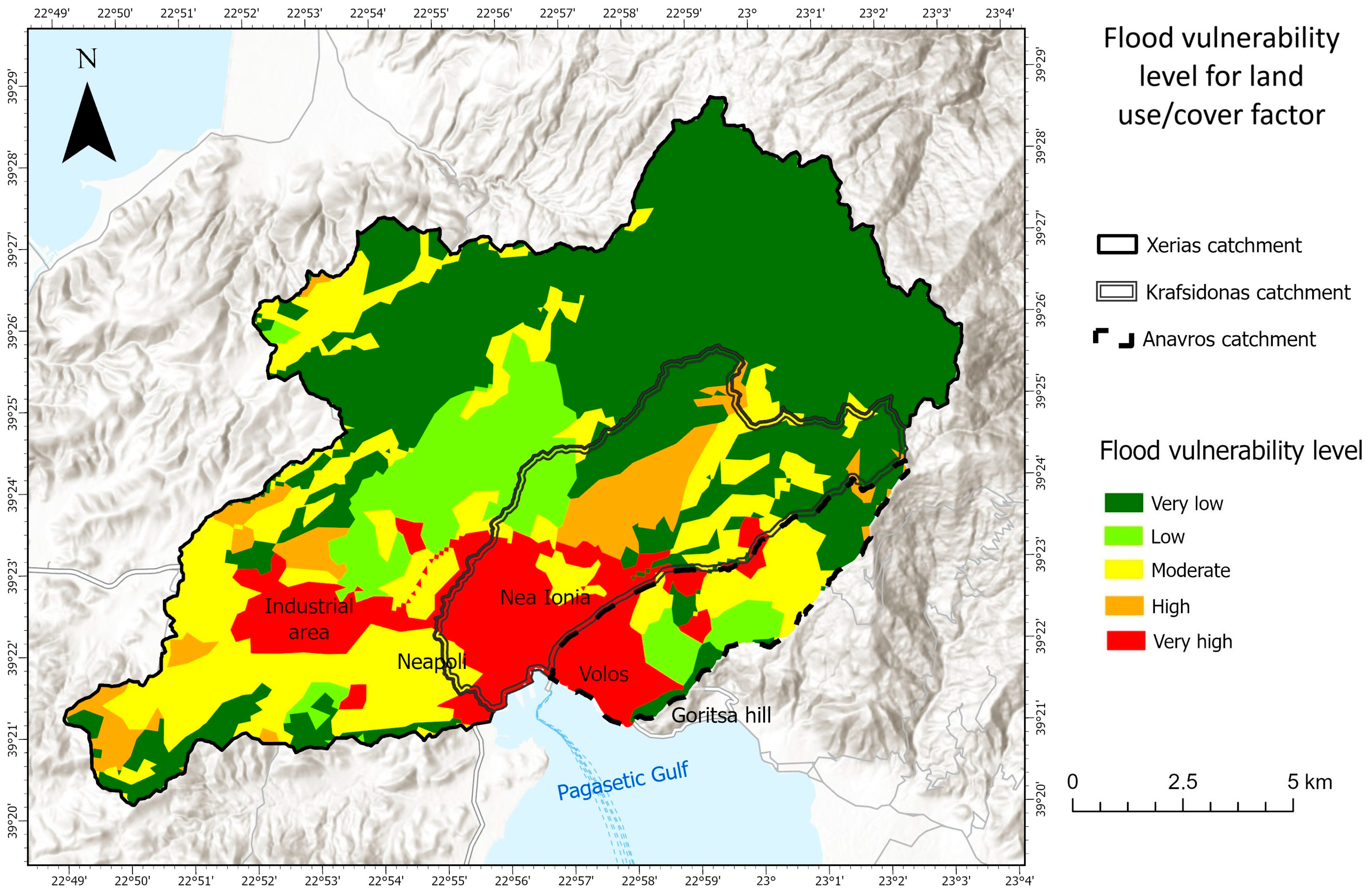
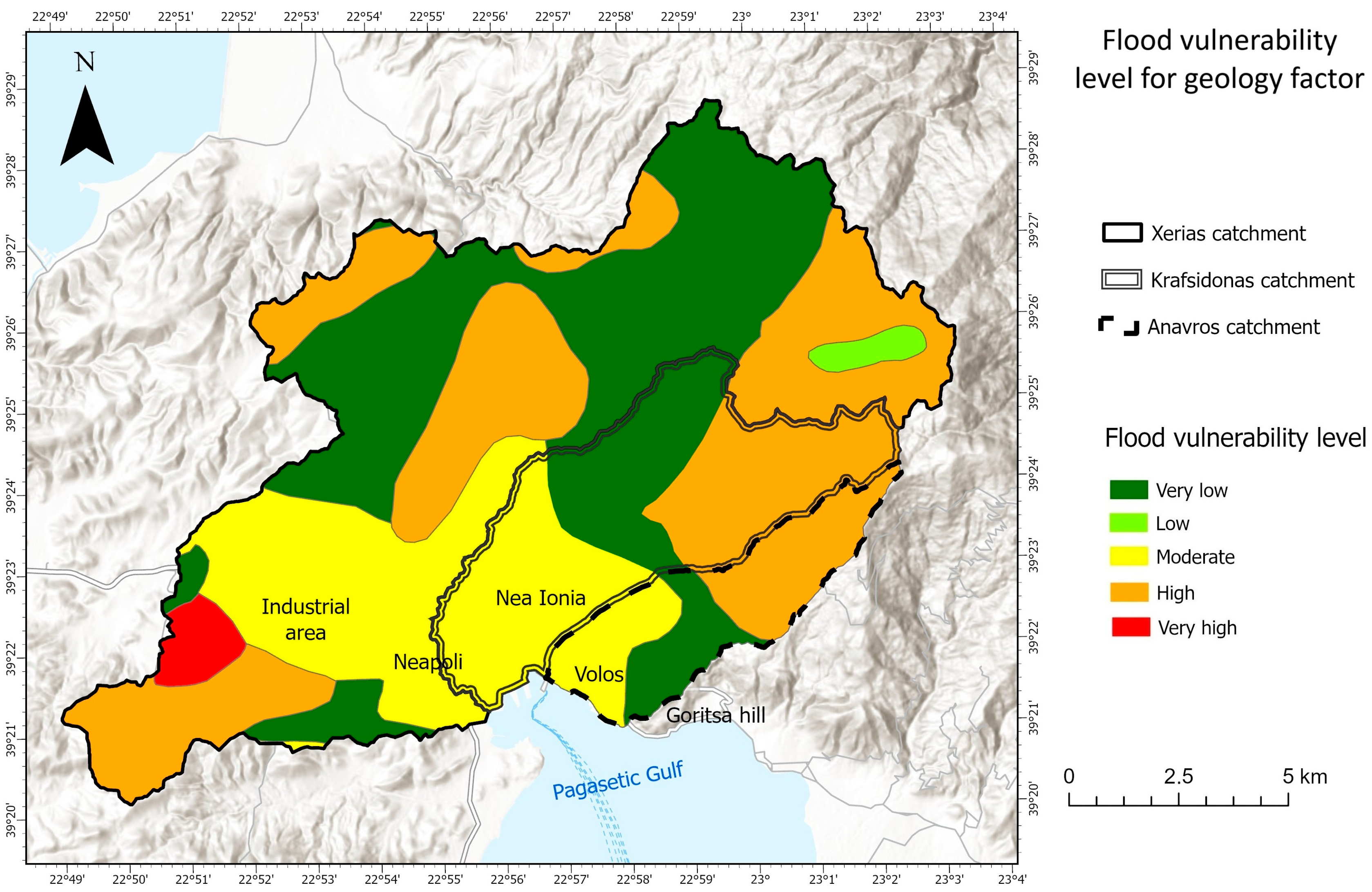
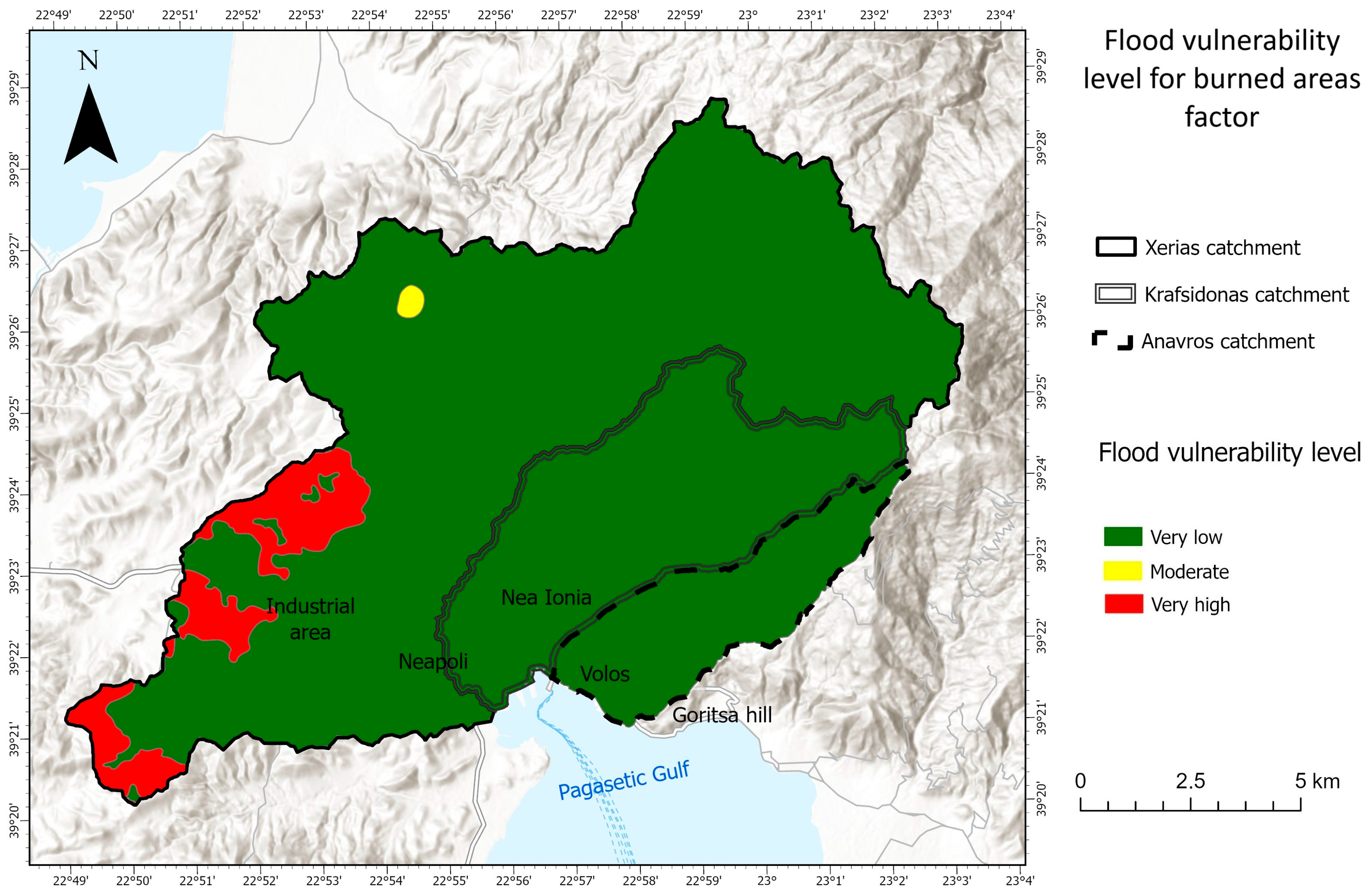
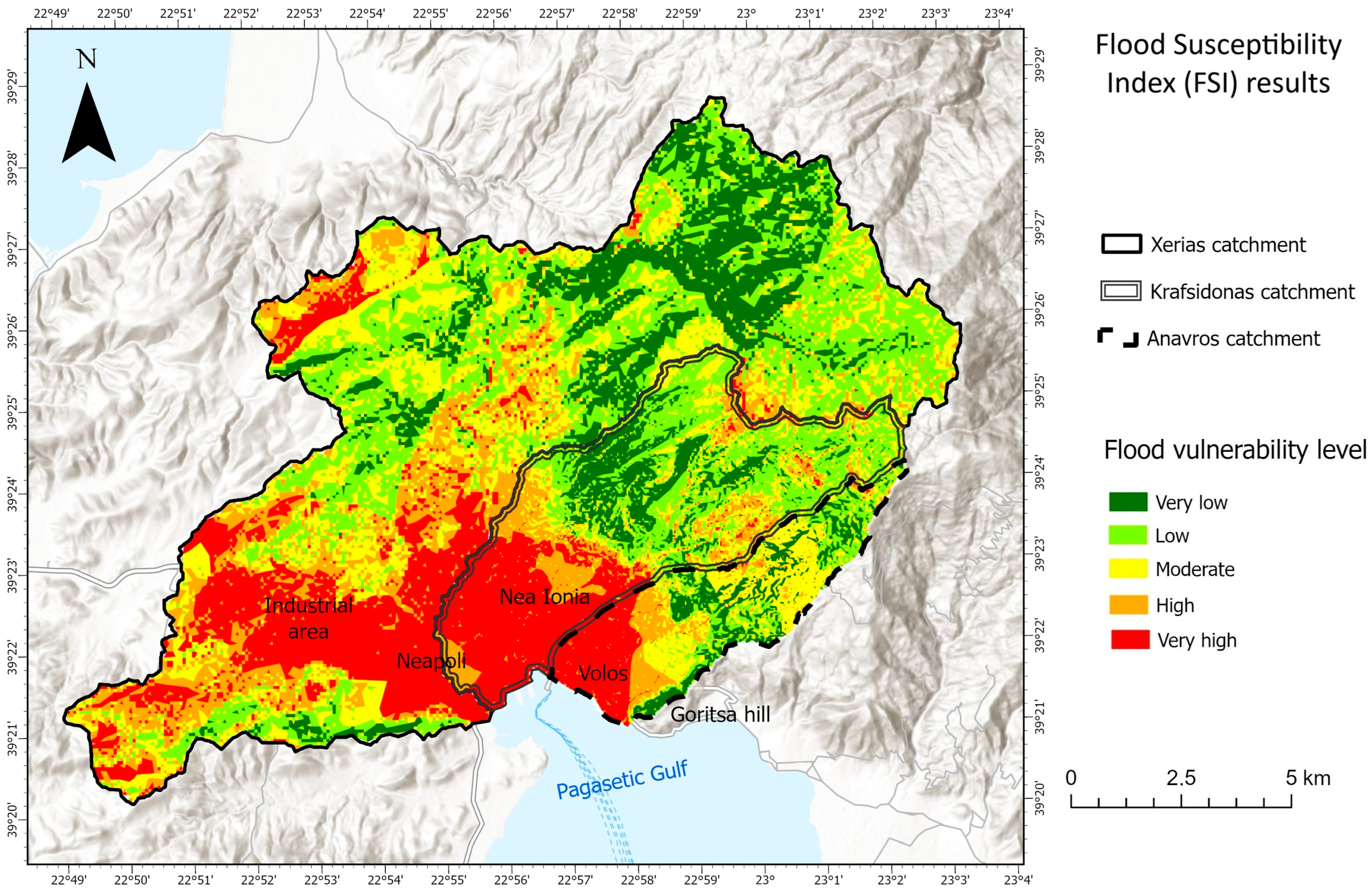

| Factor | Class | Numerical Value |
|---|---|---|
| Slope (°) | ≤7 | 5 |
| 7–15 | 4 | |
| 15–22 | 3 | |
| 22–29 | 2 | |
| >29 | 1 | |
| Flow accumulation (pixels) | 0–32,062 (X) 0–11,116 (K) 0–8000 (A) | 1 |
| 32,062–131,166 (X) 11,116–36,526 (K) 8000–13,000 (A) | 2 | |
| 131,166–233,184 (X) 36,526–60,348 (K) 13,000–25,000 (A) | 3 | |
| 233,184–507,176 (X) 60,348–142,929 (K) 25,000–35,000 (A) | 4 | |
| 507,176–743,276 (X) 142,929–202,484 (K) 35,000–53,000 (A) | 5 | |
| Land use/cover | Forest and dense vegetation | 1 |
| Olive groves | 2 | |
| Agricultural lands | 3 | |
| Mineral extraction sites, dump sites, sparsely vegetated areas | 4 | |
| Continuous and discontinuous urban fabric, industrial or commercial units, road and rail networks, port areas, construction sites, sport and leisure facilities, coastal wetlands | 5 | |
| Geology | Permeable formations with high to very high permeability | 1 |
| Permeable formations with moderate to high permeability | 2 | |
| Semi-permeable formations with moderate permeability | 3 | |
| Semi-permeable formations with low permeability | 4 | |
| Impermeable formations | 5 | |
| Flood history | Number of flood events per 100 km2 | 4 |
| Burned areas | Non burned areas | 1 |
| 2018 forest fire | 3 | |
| 2023 forest fire | 5 |
| Scale | Numerical Rating | Reciprocal |
|---|---|---|
| Extremely importance | 9 | 1/9 |
| Very to extremely strongly importance | 8 | 1/8 |
| Very strongly importance | 7 | 1/7 |
| Strongly to very strongly importance | 6 | 1/6 |
| Strongly importance | 5 | 1/5 |
| Moderately to strongly importance | 4 | 1/4 |
| Moderately importance | 3 | 1/3 |
| Equally to moderately importance | 2 | 1/2 |
| Equally importance | 1 | 1 |
| Number of Criteria (n) | 1 | 2 | 3 | 4 | 5 | 6 | 7 | 8 | 9 | 10 |
| Random Index (RI) | 0 | 0 | 0.58 | 0.9 | 1.12 | 1.24 | 1.32 | 1.41 | 1.45 | 1.49 |
| Morphological Slope (°) | Vulnerability Level | Xerias | Krafsidonas | Anavros | |||
|---|---|---|---|---|---|---|---|
| km2 | % | km2 | % | km2 | % | ||
| 0–7 | Very High | 34.11 | 29.45 | 13.41 | 36.65 | 6.13 | 38.41 |
| 7.001–15 | High | 41.18 | 35.55 | 7.34 | 20.06 | 3.58 | 22.43 |
| 15.001–22 | Moderate | 25.62 | 22.12 | 7.34 | 20.06 | 3.92 | 24.56 |
| 22.001–29 | Low | 10.04 | 8.67 | 5.20 | 14.21 | 1.92 | 12.03 |
| 29.001–64.537 | Very Low | 4.88 | 4.21 | 3.30 | 9.02 | 0.41 | 2.57 |
| Total | 115.83 | 100 | 36.59 | 100 | 15.96 | 100 | |
| Flow Accumulation (Pixels) | Vulnerability Level | Xerias | Krafsidonas | Anavros | |||
|---|---|---|---|---|---|---|---|
| km2 | % | km2 | % | km2 | % | ||
| 0–32,062 (X) 0–11,116 (K) 0–8000 (A) | Very Low | 115.41 | 99.64 | 16.35 | 99.34 | 15.85 | 99.31 |
| 32,062–131,166 (X) 11,116–36,526 (K) 8000–13,000 (A) | Low | 0.19 | 0.16 | 0.16 | 0.44 | 0.01 | 0.06 |
| 131,166–233,184 (X) 36,526–60,348 (K) 13,000–25,000 (A) | Moderate | 0.09 | 0.08 | 0.03 | 0.08 | 0.03 | 0.19 |
| 233,184–507,176 (X) 60,348–142,929 (K) 25,000–35,000 (A) | High | 0.11 | 0.09 | 0.04 | 0.11 | 0.02 | 0.13 |
| 507,176–743,276 (X) 142,929–202,484 (K) 35,000–53,000 (A) | Very High | 0.03 | 0.03 | 0.01 | 0.03 | 0.05 | 0.31 |
| Total | 115.83 | 100 | 36.59 | 100 | 15.96 | 100 | |
| Land Use/Cover | Vulnerability Level | Xerias | Krafsidonas | Anavros | |||
|---|---|---|---|---|---|---|---|
| km2 | % | km2 | % | km2 | % | ||
| Coniferous forest, broad-leaved forest, mixed forest, transitional woodland-shrub, sclerophyllous vegetation | Very Low | 62.02 | 53.54 | 12.07 | 32.99 | 3.32 | 20.80 |
| Olive groves | Low | 13.09 | 11.30 | 2.17 | 5.93 | 2.73 | 17.11 |
| Complex cultivation patterns, fruit trees and berry plantations, land principally occupied by agriculture with significant areas of natural vegetation, pastures | Moderate | 28.09 | 24.25 | 6.93 | 18.94 | 4.42 | 27.69 |
| Mineral extraction sites, dump sites, sparsely vegetated areas, natural grasslands | High | 5.45 | 4.71 | 5.37 | 14.67 | 0.25 | 1.57 |
| Continuous urban fabric, discontinuous urban fabric, industrial or commercial units, road and rail networks, port areas, construction sites, sport and leisure facilities, coastal wetlands | Very High | 7.18 | 6.20 | 10.05 | 27.47 | 5.24 | 32.8 |
| Total | 115.83 | 100 | 36.59 | 100 | 15.96 | 100 | |
| Geology | Vulnerability Level | Xerias | Krafsidonas | Anavros | |||
|---|---|---|---|---|---|---|---|
| km2 | % | km2 | % | km2 | % | ||
| Permeable formations with high to very high permeability | Very Low | 44.20 | 38.16 | 10.73 | 29.33 | 4.47 | 28 |
| Permeable formations with moderate to high permeability | Low | 1.68 | 1.45 | 0 | 0 | 0 | 0 |
| Semi-permeable formations with moderate permeability | Moderate | 24.29 | 20.97 | 13.43 | 36.62 | 4.79 | 29.64 |
| Semi-permeable formations with low permeability | High | 42.78 | 36.93 | 12.46 | 34.05 | 6.76 | 42.36 |
| Impermeable formations | Very High | 2.88 | 2.49 | 0 | 0 | 0 | 0 |
| Total | 115.83 | 100 | 36.59 | 100 | 15.96 | 100 | |
| Number of Flood Events per 100 km2 | Vulnerability Level |
|---|---|
| <0.2 | Very low |
| 0.3–0.4 | Low |
| 0.5–0.7 | Moderate |
| 0.8–1.0 | High |
| >1 | Very high |
| Burned Areas | Vulnerability Level | Xerias | Krafsidonas | Anavros | |||
|---|---|---|---|---|---|---|---|
| km2 | % | km2 | % | km2 | % | ||
| Forest fire 26 July 2023 | Very High | 10.09 | 8.71 | 0 | 0 | 0 | 0 |
| Forest fire 14 June 2018 | Moderate | 0.36 | 0.31 | 0 | 0 | 0 | 0 |
| Non-burned areas | Very Low | 105.38 | 90.98 | 36.59 | 100 | 15.96 | 100 |
| Total | 115.83 | 100 | 36.59 | 100 | 15.96 | 100 | |
| Criteria | Slope | Flow Accumulation | Geology | Land Use/Cover | Flood History | Burned Areas |
|---|---|---|---|---|---|---|
| Slope | 1 | 2 | 3 | 3 | 5 | 7 |
| Flow accumulation | 0.5 | 1 | 2 | 3 | 4 | 5 |
| Geology | 0.33 | 0.5 | 1 | 2 | 3 | 4 |
| Land use/cover | 0.33 | 0.33 | 0.5 | 1 | 2 | 3 |
| Flood history | 0.2 | 0.25 | 0.33 | 0.5 | 1 | 3 |
| Burned areas | 0.14 | 0.2 | 0.25 | 0.33 | 0.33 | 1 |
| Sum | 2.5 | 4.28 | 7.08 | 9.83 | 15.33 | 23 |
| Geometric Mean of Comparison Values | Weighting Coefficients | WV | C |
|---|---|---|---|
| 2.927903496 | 0.373633644 | 2.292297058 | 6.135146265 |
| 1.978602446 | 0.252492080 | 1.546448839 | 6.124741975 |
| 1.257812378 | 0.160511104 | 0.982810803 | 6.123008181 |
| 0.829898263 | 0.105904417 | 0.646268426 | 6.10237462 |
| 0.539836859 | 0.068889297 | 0.428368293 | 6.218212593 |
| 0.302241656 | 0.038569458 | 0.239186286 | 6.201442729 |
| 7.836295098 | 1 | λmax--> | 6.150821061 |
| For number of criteria n = 6, RI = 1.24 | CI--> | 0.030164 | |
| CI = (λmax − ν)/(ν − 1) and CR = CI/RI | CR--> | 0.024325 |
| Vulnerability Level | Xerias | Krafsidonas | Anavros | Study Area | ||||
|---|---|---|---|---|---|---|---|---|
| km2 | % | km2 | % | km2 | % | km2 | % | |
| Very Low | 18.68 | 16.13 | 5.42 | 14.81 | 3.06 | 19.17 | 27.16 | 16.13 |
| Low | 32.53 | 28.08 | 10.56 | 28.86 | 2.54 | 15.92 | 45.63 | 27.11 |
| Moderate | 26.68 | 23.03 | 5.55 | 15.17 | 4.82 | 30.2 | 37.05 | 22 |
| High | 17.39 | 15.01 | 5.66 | 15.47 | 2.11 | 13.22 | 25.16 | 14.94 |
| Very High | 20.55 | 17.75 | 9.4 | 25.69 | 3.43 | 21.49 | 33.38 | 19.82 |
| Total | 115.83 | 100 | 36.59 | 100 | 15.96 | 100 | 168.38 | 100 |
| Sensitivity Analysis—Xerias Catchment | |||
|---|---|---|---|
| Flood Vulnerability Level | Initial Results (%) | Results After Modification (%) | Percentage Difference (%) |
| Very low | 16.13 | 16.05 | −0.08 |
| Low | 28.08 | 27.70 | −0.38 |
| Moderate | 23.03 | 22.69 | −0.34 |
| High | 15.01 | 13.10 | −1.91 |
| Very high | 17.75 | 20.46 | +3.31 |
Disclaimer/Publisher’s Note: The statements, opinions and data contained in all publications are solely those of the individual author(s) and contributor(s) and not of MDPI and/or the editor(s). MDPI and/or the editor(s) disclaim responsibility for any injury to people or property resulting from any ideas, methods, instructions or products referred to in the content. |
© 2025 by the authors. Licensee MDPI, Basel, Switzerland. This article is an open access article distributed under the terms and conditions of the Creative Commons Attribution (CC BY) license (https://creativecommons.org/licenses/by/4.0/).
Share and Cite
Rodopoulos, C.; Saitis, G.; Evelpidou, N. Physical Flood Vulnerability Assessment in a GIS Environment Using Morphometric Parameters: A Case Study from Volos, Greece. Water 2025, 17, 2449. https://doi.org/10.3390/w17162449
Rodopoulos C, Saitis G, Evelpidou N. Physical Flood Vulnerability Assessment in a GIS Environment Using Morphometric Parameters: A Case Study from Volos, Greece. Water. 2025; 17(16):2449. https://doi.org/10.3390/w17162449
Chicago/Turabian StyleRodopoulos, Christos, Giannis Saitis, and Niki Evelpidou. 2025. "Physical Flood Vulnerability Assessment in a GIS Environment Using Morphometric Parameters: A Case Study from Volos, Greece" Water 17, no. 16: 2449. https://doi.org/10.3390/w17162449
APA StyleRodopoulos, C., Saitis, G., & Evelpidou, N. (2025). Physical Flood Vulnerability Assessment in a GIS Environment Using Morphometric Parameters: A Case Study from Volos, Greece. Water, 17(16), 2449. https://doi.org/10.3390/w17162449








